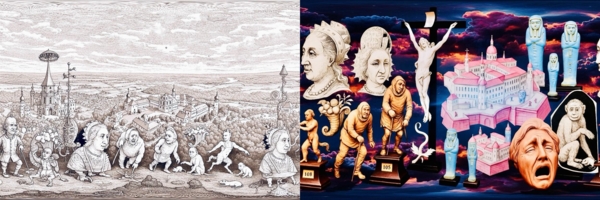A digital Wunderkammer (cabinet of curiosities) as an immersive space of experience.
Background
During the Renaissance, so-called Kunst- und Wunderkammern (cabinets of curiosities) were highly popular. They can be regarded as precursors of today’s museums and art collections and were conceived as miraculous places of wonder. They not only served purposes of entertainment but were also meant to inspire reflection, stimulate new insights, and make the complexity of the world sensually tangible.
The Wunderkammer at Göttweig Abbey, which dates back to the early 18th century, was primarily intended to enable interpretations from the perspective of religion. At the same time, it bears witness to a systematic pursuit of knowledge and the late Baroque desire for representation.
Project Content
The Wunderkammer commissioned by Abbot Gottfried Bessel between 1714 and 1749 is more than a historical artifact. It can be seen as a conceptual space between memory and imagination, the visible and the invisible. It links nature and art, faith and knowledge, matter and spirit.
Through transdisciplinary research and artistic practice, we are reimagining Göttweig’s historical collection by transforming it into a digital Wunderkammer. Rather than a simple reconstruction, we envision a digital transformation that enables immersive experiences. We also place great emphasis on sustainability and on ensuring that existing digital assets can be used beyond the duration of the project. Ultimately, we build a contemporary, poetic space of wonder — open, vibrant, and polyphonic.
Goals and Approach
The project uses transdisciplinary methodology, that marries scientific research with artistic and digital media practices. Instead of creating exact digital replicas, we form speculative objects where historical reconstruction meets artistic imagination.
We design the Wunderkammer not as a fixed space, but as a fluid, multisensory environment. Movement, perspective shifts, and interaction are enabled through immersive technologies such as Extended Reality (XR), Virtual Reality (VR), Augmented Reality (AR), and AI-driven methods and machine learning.
We aim to create a layered artistic exploration that connects historical themes with contemporary questions of digital culture, ecology, and epistemology. At the heart of the project lies wonder — not as naïve astonishment, but as a way of acquiring knowledge and gaining new insights. We seek not to impress through mere entertainment, but to spark curiosity that leads to deeper understanding. In other words, we are creating a space of possibilities that spans nature, art, and spirituality.
This project is designed for a diverse audience. The Wunderkammer is more than a museum exhibit — it is a “Third Space,” where perspectives, disciplines, and forms of knowledge melt together and grow into something new. It speaks to cultural and art enthusiasts, researchers, historians, artists, designers, creatives, and educational institutions alike.
Funding
You want to know more. Feel free to ask.
Lecturer
Department of Media and Digital Technologies
Elias van-Gils, BSc
- UWK Universität für Weiterbildung Krems, Plattform für Nachhaltige Entwicklung (lead)
- Stift Göttweig, Kunstsammlungen/Archiv & Bibliothek
- Verein DruckKunst, Verein zur Förderung und Verbreitung der bildenden Künste/Neuhauser Kunstmühle



